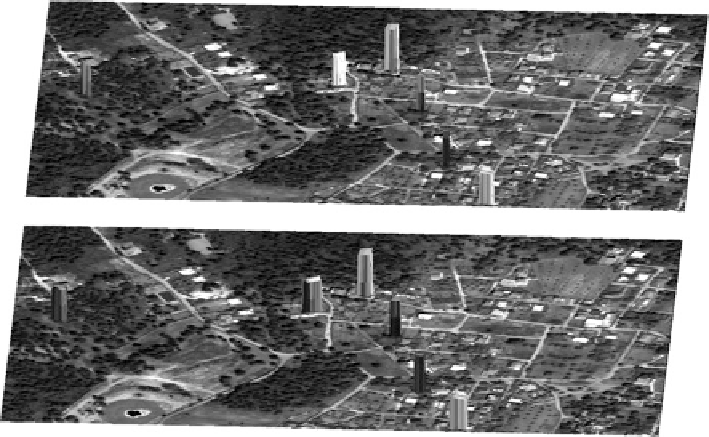Geoscience Reference
In-Depth Information
Fig. 10.4
The detected changes (new buildings) in 3D after the application of the unsupervised
change detection procedure on QuickBird 2007 and 2009 satellite data. The detected new building
in 3D are shown in the
upper
part, while the 3D buildings from the ground truth data are shown
in the
bottom
. After a close inspection one can observe the low completeness and high correctness
detection rates of the unsupervised change detection algorithm
(Blaschke
2010
). Multilevel segmentation and supervised classification are the
main key process there (Tzotsos et al.
2011
,
2014
). Recent object-based change
detection approaches (Table
10.4
) include scale space filtering and multivariate
alteration detection (Doxani et al.
2012
), the combination with multi-view airborne
laser scanning data (Hebel et al.
2013
), the detection of impervious surfaces (Xian
and Homer
2010
), shaded areas (Zhou et al.
2009
), landslides (Lu et al.
2011b
),
and building damage assessment after earthquakes (Brunner et al.
2010
). Another
promising combination is to employ data mining techniques under an object-
based framework in order to address big datasets and dense, long-term time series
(Schneider
2012
).
To this end, algorithms focusing on knowledge discovery in databases aim
at extracting/mining nontrivial, implicit information from unstructured datasets.
In particular, for geospatial datasets, data mining techniques are exploiting spatial
and nonspatial properties in order to discover the desired knowledge/data. Dos
Santos Silva et al. (
2008
) proposed a data mining framework which associates
each change pattern to one predefined type of change by employing a decision-
tree classifier to describe shapes found in land-use maps. Boulila et al. (
2011
)
employed fuzzy sets and a data mining procedure to build predictions and decisions.
Based on the imperfections related to the spatiotemporal mining process, they
proposed an approach towards a more accurate and reliable information extrac-
tion of the spatiotemporal land-cover changes. Vieira et al. (
2012
) introduced a

Search WWH ::

Custom Search